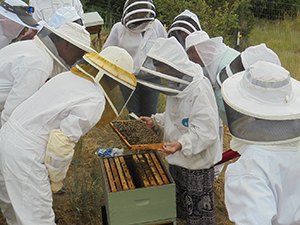
Imagine this scene in your mind. It won’t be difficult, we have all seen it already. At a club meeting a new-bee asks about checking on the bees’ feed situation in the spring. Without even waiting to hear the whole question, a three-year-wonder from the back of the room shouts, “You can’t open the hive yet, you’ll kill the bees!” He goes on to say that it will take the bees too long to re-heat the hive, and it will cause them to eat more honey (the fuel for heater bees), and finishes by asking everyone to imagine how it would be if they ran out of firewood in the winter. This scenario gives us plenty of examples of bad beekeeping advice, and how to recognize it.
First, who is giving the advice? What I refer to as a “three-year-wonder” is someone who thinks they know everything about bees, but in reality doesn’t even know how much they don’t know yet.
Shall we just take all advice from more experienced beekeepers? Not necessarily. Digging a little deeper, we discover that the advice-giver, whether new, old or in-between, loses 80% of their bees every year. Since 30% losses are average, maybe a good benchmark would be giving more credence to those who lose less than 30%. We also find that the advice-giver lives 1000’ higher in elevation from our apiary, and that several other circumstances are very different.
This is similar to surfing forums on the internet, where you have no way of knowing what circumstances the advice-giver is in. There may be several other mitigating issues going on. It pays to ask a few questions of your own before you decide if this advice will work in your situation.
But back to our example: Another clue that this is bad advice is that he didn’t ask any questions before offering his opinion. For instance, a good advice-giver might have asked about the race of honey bees, why you are concerned, and whether you have tried hefting the hive. Someone worrying more about Italian bees running out of honey would not be out of line. Good advice comes from beekeepers who take the time to fully understand your situation and all of the circumstances in your hive.
Yet another clue comes from the bad advice-giver asking us to imagine ourselves in the bees’ place, with no firewood. He is appealing to our emotions and asking us to anthropomorphize (imagine that bees think, act, and feel like humans do). Rather than imagining that bees think like people, it will do more good for us to think like a bee. What I mean is, use what you know about bee biology and behavior to figure out what they need. This sets emotion aside and asks us to use science and knowledge in our decision making. It is a scientific fact that bees do not heat the interior of the hive, they warm the cluster only. A thermometer placed inside the hive away from the cluster shows that the interior is only a degree or two warmer than the outside temperature.
Better advice in this situation would be to heft the hive from the back or side to gauge its weight so that you don’t have to open it unnecessarily. The bees are all right for a while if it is dead-heavy (a beekeeping term). If you aren’t sure how heavy it should be, popping the top to quickly peek in and see if the bee candy is still in place is appropriate. Be prepared to replace the candy with more, with fondant, or with the mountain camp method (dry sugar over newspaper) so that one quick opening is all that will be needed. It is best to do this on a day that is at least 40 degrees, if possible.
If you didn’t add bee candy in the fall, just check to see where the bees are. If they are obviously at the top of the top box, you know that ….


